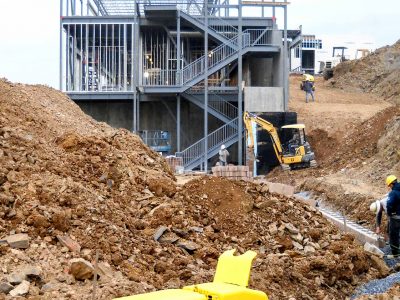What is Certificate of Completion and Compliance (C.C.C)
Forms Used
Besides the Stage Certification forms, the implementation of CCC system involves the use of both new and existing forms.
For more information, please visit FAQ for CCC or can refer to Risalah Perakuan Siap dan Pematuhan
Introduction
In April 2007, the Government had launched the improvement to the building delivery system to enhance the competitiveness of Malaysia globally. This includes the issuance of the Certificate of Completion and Compliance (CCC) by Professional Architects and Professional Engineers as well as Building Draughtsman registered with the Board of Architects Malaysia (BAM) and the Board of Engineers Malaysia (LJM) to replace the Certificate of Fitness for Occupation (CFO) issued by the local authorities. This new system is an effort towards self-certification and self-regulation approach in the construction industry.
Terminologies
With the implementation of the CCC system, a number of new terminologies were introduced.
- ‘Principal submitting person’ (PSP) refers to a qualified person who submits building plans to the LA for approval. It includes any other qualified person who takes over the duties and responsibilities of PSP;
- ‘Submitting person’ (SP) means a qualified person, and any other qualified person taking over his duties and responsibilities , who submits plans other than building plans to the LA or relevant statutory authority;
- ‘Qualified person’ means a Professional Architect, Professional Engineer or registered Building Draughtsman registered with the bodies relating to their registration;
- ‘Building plan’ means plans that include site plans, key plans, floor plans, building sections and elevations;
- ‘Technical conditions’ refer to those conditions relating to the issues of health and safety of the building as well as essential services provided for the building;
- ‘Stage certification’ is a process introduced under the CCC system where the completion and compliance of every building component are required to be certified by the professionals and contractors who are responsible for the completion of the particular component. This certification process is carried out in stage according to the progress of construction;
- ‘Non-technical conditions’ refer to those conditions imposed by the LC in approving the Planning Permission and Building Plan that are usually intended to fulfill certain social development needs. These conditions are either inside or outside of the approved layout plan. Among the non-technical conditions commonly imposed include that of Bumiputra quota, construction of low-cost housing in mixed housing development and contribution for the provision of public amenities. In the CCC system, the PSP is not responsible for ensuring compliance to the non-technical conditions;
- ‘Layout plan’ are the proposed plans of a development in a specific scale, which include general planning and positioning of buildings in the development with respect to the local planning and internal layout of buildings or area of development so that proposed layout plans mirror those on the site;
- ‘Notice of vacant possession’ is the notice issued by the seller, which is the developer, informing the buyer to take possession of the said property; and
- ‘Vacant possession’ is issued by the seller allowing the buyer to take possession of the property subject to the construction being duely completed as certified by the Architect for the buyer, water and electrical supplies having been connected to the said building, the buyer having made full payment under the law and that for housing it is accompanied with the CCC.
The Professionals Responsible for the Issuance of CCC
- The CCC will be issued by the Professional Architect or Professional Engineer who is registered with the respective Board of Architects Malaysia (BAM) or Board of Engineers Malaysia (BEM) acting in the capacity of PSP.
- For buildings which require intensive design input, the Professional Architect will function as the PSP while the Professional Engineer will be the PSP for the projects with high engineering input in nature.
- For the bungalows which do not exceed 2 floors in height and 300 square metres in total built up floor area, a registered Building Draughtsman may perform the role of PSP and issue the CCC.
- The CCC can only be issued when all parties concerned are satisfied that the building construction have been supervised and completed in full compliance with the provisions of the law and technical conditions as imposed by the LA in approving the Planning Permission and Building Plan.
Approval of Planning Permission and Building Plan
- Under CCC, Planning Permission and Building Plan are still required for submission and approval by the LA.
- While PSP’s major responsibility is to submit Building Plan, other plans can be submitted by the SP, that is either the Professional Architect or Professional Engineer.
Technical and Non-Technical Conditions
- PSP is responsible for ensuring the compliance to the technical conditions imposed by the LA as the technical conditions are directly related to the safety and stability of the building being erected and in fact, within the control of the professionals. While the owner or the developer is fully responsible for the non-technical conditions.
- Technical conditions are classified into 3 categories:-
- The technical conditions within the building that relate to the health and safety aspects of the building
- The technical conditions outside the building but within the development area that relate directly to the building and development i.e. elements of open spaces with landscaping and recreational facilities
- The technical conditions outside the project area that are linked directly to the related development, i.e. the access road and utility infrastructure that are outside the project area
- Besides the technical requirements and building specifications that are enforceable by the provisions of existing laws and regulations, the LA also impose non-technical conditions to implement the policies of the State Government in fulfilling certain socio-economic development needs. Example of conditions usually imposed by the LA would include:-
- The construction of low-cost houses in mixed housing development;
- The bumiputra quota in the development
- The developer’s financial contribution for the provision of social facilities
Stage Certification Process
- Under the CCC system, 21 building components have being identified for the stage certification process. 21 Stage Certification Forms (Form G 1 to G 21) have been introduced under the Second Schedule of the UBBL 2007.
- Type of forms to be used in accordance with the building components and the responsible parties involved in the stage certification process
Roles and Responsibilities of the LA and the PSP
LOCAL AUTHORITY
- Approve the Planning Permission
- Approve the Building Plan
- Conduct on-site inspections on own initiative or in response to complaints
- Issue notice to PSP to take action on any matter not in compliance with the provisions of the law and the technical conditions imposed in the Planning Permission and Building Plan
- Issue notice to the PSP to withhold the issuance of the CCC
- Until the non-compliances have been rectified
- If a fraud occurs in the construction, documentation or project management, and
- If inaccurate information is discovered in the documentation
- Issue the notice to PSP if a non-compliance occurs but not reported to the LA
- Charge the professional in court and report to the Professional Board for any wrongdoings
- Charge the parties who have provided false certification in the forms as specified in the UBBL 2007 and report them to the respective regulatory bodies
- Ensure that buildings exceeding 5 floors and aging 10 years from the date CCC is issued are inspected every 10 years, and
- Issue CFO for development which submitted building plan have been approved or for buildings that are completed before the coming into operation of the CCC system
PSP
- Submit the Building Plan to the LA for approval using Form A
- Coordinate the preparation, commence and submission of other plans besides building plans
- Inform the LA through Form B to construction operation at the site
- Supervise construction works at the site and ensure that the provisions of the law and technical conditions imposed are complied with
- Report and explain the reasons for non-compliance and state the rectification measures taken in the event of non-compliance occurring during construction
- Submit notice for the resumption of work through Form B to the LA
- Ensure that G Forms are duly completed and deposit copies of all said Forms (including those not related) to the LA and Professional Board
- Submit the CCC to the owner or developer and a copy of the said certificate to the LA and the relevant Professional Board, and
- Ensure that the rectification of non-compliances during construction as stipulated in the LA notice to the PSP are complied with before issuing the CCC
CCC Issuing Process
Under By-law 25 of the UBBL 2007, the PSP can issue the CCC using Form F subject to the following conditions being met:-
- When all technical conditions imposed by the LA have been satisfactorily complied with
- When Form G 1 and Form G 21 in respect of stage certification as set out in the Second Schedule have been duly certified and received by him
- When all the essential services, including access roads, landscape, car parks, drains, sanitary, water and electricity installations, fire hydrants, sewerage and refuse disposal requirements and fire lifts, where required, have been provided
- When he certifies in Form F that he has supervised the erection and completion of the building and that to the best of his knowledge and belief the building has been constructed and completed in accordance with Act 133, the UBBL and the approved plans




